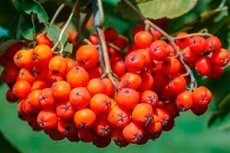
All iLive content is medically reviewed or fact checked to ensure as much factual accuracy as possible.
We have strict sourcing guidelines and only link to reputable media sites, academic research institutions and, whenever possible, medically peer reviewed studies. Note that the numbers in parentheses ([1], [2], etc.) are clickable links to these studies.
If you feel that any of our content is inaccurate, out-of-date, or otherwise questionable, please select it and press Ctrl + Enter.
Black and red rowanberries in diabetes mellitus
Medical expert of the article
Last reviewed: 04.07.2025

Rowan berries are also allowed for diabetes. In this case, preference is given to black chokeberries, which have sugar-lowering properties.
But the common rowan with bright orange fruits, which acquire a red tint in the cold, is very useful for vision due to its high content of vitamin A and helps prevent the development of diabetic retinopathy.
 [ 1 ]
[ 1 ]
Benefits
Both types of rowan have a rich vitamin composition: vitamins A, C (in chokeberry, its content is equal to currant), E, bioflavonoids (in high concentrations). Red rowan contains 4 vitamins of group B, and in chokeberry there are already 6 of them plus vitamin K. In terms of vitamin C content, chokeberry prevails over red, but the latter has a significantly higher concentration of vitamin A, which is useful for vision.
Red rowan contains large amounts of potassium, magnesium and copper, and smaller amounts of calcium, phosphorus, iron, manganese and zinc. In terms of microelement content, black chokeberry is slightly inferior to red rowan, but it is able to accumulate iodine, which is necessary for the proper functioning of the thyroid gland. The fact is that disruptions in the functioning of this important endocrine organ (increased or decreased production of thyroid hormones) are fraught with the development of all sorts of complications in patients with diabetes. Patients with hyperthyroidism have increased blood glucose levels, which is a potentially dangerous condition. While with a deficiency of thyroid hormones, edema syndrome develops, the level of harmful cholesterol, which settles on the walls of blood vessels, increases, and the progression of atherosclerosis can lead to a stroke or myocardial infarction.
Red rowan is considered a source of useful substances, but does not have a noticeable sugar-lowering effect on diabetes. But it can reduce high blood pressure, have a beneficial choleretic and diuretic effect, and have a positive effect on bowel function, gently preventing constipation. It can be used as a general tonic and for the prevention of vision disorders. The glycemic index of rowan is low (25-30 units), the caloric content is only 43 kcal, and the carbohydrate content in 100 g of the product is slightly less than 12 g. Such berries can be consumed 150-250 g per day.
But black chokeberry is considered especially useful for diabetes, despite its rather high carbohydrate content (13.5 g) and slightly increased caloric content (52 kcal). It is believed that this berry can cleanse the body of toxins, improve bowel function, have an antispasmodic and choleretic effect, remove harmful cholesterol, normalize liver function, and improve immunity. The great benefit of black chokeberry for diabetes is its ability to normalize blood pressure, stabilize the endocrine system, lower blood sugar, stop inflammatory processes, and heal wounds on the body.
Black rowan berries (aronia) are able to stop bleeding and have a disinfecting effect. In connection with this, the juice of the berries can be used to treat wounds on the skin and mucous membranes that occur with diabetes.
Rowan berries can be eaten fresh (common rowan berries should be picked after frost or frozen in the freezer so that the berries become softer and juicier), made into delicious compotes and jelly, juice and jam, using sugar substitutes as a sweetener.
Rowan juice is recommended to be consumed before meals 3-4 times a day, ¼ cup. If a person prefers berries, then it is recommended to eat chokeberries 1 cup a day.
To prepare tea and medicinal infusions, both rowan berries and leaves are used (1-2 tablespoons per glass of boiling water). Compote is prepared in the same way, pouring boiling syrup made from water and sugar substitute over fresh fruits. And to prepare jam, the fruits poured with syrup should be boiled twice with an interval of approximately 8 hours.
Contraindications
Black chokeberry and red rowan are somewhat different in their chemical composition and effects on the human body, but this does not apply to contraindications to their use. In this, both varieties of the plant are similar.
Rowan is not recommended for consumption in case of certain pathologies of the circulatory system, such as increased blood viscosity and predisposition to thrombosis, varicose veins, myocardial ischemia. It is worth being careful about eating berries after recent heart attacks and strokes.
In case of ulcerative and inflammatory diseases of the stomach and duodenum, consumption of fresh rowan berries can provoke an exacerbation of the disease.

